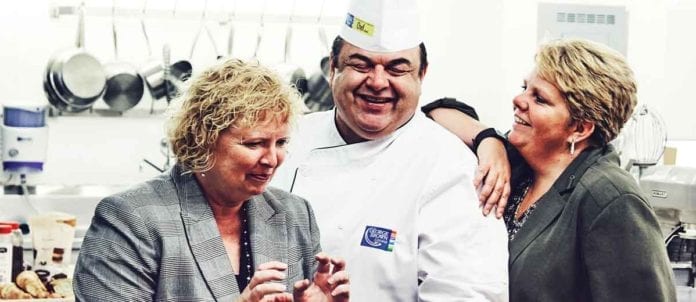Back in 2012, pastry chef Olivier Fernández of Spain’s Escuela de Pastelería del Gremio de Barcelona boosted the popularity of “bean-to-bar” chocolate-making when he pioneered a technique for producing micro-batches in a small conche — consequently raising the demand for chocolate artisans around the world.
The past few years have seen a spike in bean-to-bar chocolatiers across Canada, such as Quebec’s Chaleur B Chocolat, Ontario’s Hummingbird Chocolate Maker (Almonte), Ultimately Chocolate on Manitoulin Island and Winnipeg’s Aschenti Cocoa to name just a few. These small-batch, from-scratch manufacturers are riding increased demand for handmade chocolate and pastry in both the retail and foodservice sectors. But where are all the new chocolatiers and pâtissiers going to come from?
Thanks in part to Redpath Sugar, Toronto’s George Brown College is stepping up to answer this challenge with a new large-quantity baking and pastry lab set to open in the fall of 2017. Located on the ground floor of the college’s Centre for Hospitality and Culinary Arts (CHCA), the lab will accommodate full-time students at the Chef School, as well as part-timers enrolled in Continuing Education classes and others working on special projects in the Food Innovation and Research Studio (FIRSt).
Enclosed by glass windows, the lab, which will be open to observers, includes a temperature-controlled space dedicated to chocolate- and candy-making, with all the equipment needed to produce small batches of chocolate right from the bean. “In all the programs at George Brown, we’re very practical and we make sure all the tools we’re using are things they’re using in industry,” says Chef School director John Higgins. “It’s all about the skills: to pipe and temper chocolate and roll pastry by hand, because if you can roll pastry by hand, then you can use the machines as well.”
“This initiative is phase two of a [Federal Economic Development Agency] project,” explains Lorraine Trotter, dean for the Centre for Hospitality and Culinary Arts. The first phase, launched in October 2015, was an applied research and industry facility, which includes renovated space for the student-run Chefs’ House restaurant, an Industry Engagement and Interaction Facility and a Beverage Research Lab.
“We’ve been working on the design and planning for construction of phase two, which includes this large-quantity pastry lab and a new showcase kitchen and demonstration theatre,” she says. “Those much-needed additions for the Centre for Hospitality and Culinary Arts have been funded by donors from our sector, federal development funds and the college.”
At an event held in April 2016, Redpath Sugar president Jonathan Bamberger presented a $360,000 cheque to the college for the new facility. A $45,000-portion of Redpath’s contribution will be channelled towards 45 awards of $1,000 each, which will be given to students enrolled in Baking and Pastry Arts Management, Baking Pre-employment and Baker/Pâtissier Apprentice programs over three years.
“Our industry partners, through our partner advisory committees and all our partner visits, told us about the need for increased graduates,” says Trotter. “This would include fine-dining, foodservice and food-manufacturing companies — with whom we do significant amounts of research — the not-for-profit sectors, food stores and feedback from international employers such as hotel chains around the world.”
With these types of industry partners, the college is able to stay ahead of changing consumer trends. “They provide feedback on how the industry is changing, particularly in the baking area, as it relates to new nutrition-related products,” says Trotter, enumerating “gluten-free and whole natural ingredients, a move towards good-quality ingredients, new ingredients from around the world and focus among consumers on quality.” Meanwhile, Higgins receives numerous phone calls from people in the industry in search of qualified graduates. “There’s a vacuum of pastry chefs,” he says.
Furthermore, “There has been a huge shift in the demand for pastries overall, but for chocolates as well,” says chef school chair Christine Walker. “Our students need to be able to understand how to make fine chocolate from scratch. Over the last couple of years, across the board [for] culinary and pastry, our industry partners have been telling us there is a focus on smaller portions but better-quality ingredients that allow for a more intense, fresh flavour, whereas 10 years ago, the trend was more on large process and packaging — which is still very prominent.”
“John and I have had quite significant involvement in our research activities at the chef school; we have a strong relationship with industry supporters for that reason,” Trotter says. “Redpath is a neighbour of George Brown [on the waterfront]. We have a strategic relationship with them. We also have a chef relationship with them, where our chefs support them in their activities.”
“What we’re great at, at George Brown, is working with people in the industry, such as David Castellan at Soma Chocolatemaker,” says Higgins. “Students have the opportunity to work with someone like him, or to work in a large company.”
“We even send all of our faculty to Callebaut in Montreal to make sure they give the most up-to-date training,” Walker says. “Another one of our partners is Nadège Pâtisserie on Queen Street West; they are also one of our premier pastry- and chocolate-makers in Toronto. We have a brand new professional Advanced French Pastry program — they do one semester with us and then they will be going to our partner Alain Ducasse. They [attend] a school in France for one month and then work in France for eight weeks.”
The new program is designed for a maximum of 24 students, but, she says, “we have deliberately started with smaller enrollment; it’s now about 16. They’ll be coming back to show off the skills they have learned in a variety of venues in Toronto, including our own pop-up pastry shop, which is open one day a week to the public at the Waterfront campus.” The shop has been so successful that “we’ve run out of product every week — using high-end product, so that’s not inexpensive,” Walker continues. “The demand is so great, we may look at expanding it. People understand the difference between a highly processed product and a made-from-scratch product using high-end, whole, natural ingredients with good technique. Our students are the ones who sell it as well, which gives them the chance to have interactions with customers.”
Recent George Brown graduates are already taking advantage of this market in businesses such as Roselle Desserts, a partnership between Stephanie Duong (a pastry graduate) and Bruce Lee (a culinary graduate), whose banana cream pie éclair was recently touted in the New York Times.
“We have to be ahead of the pack,” says Higgins. “We get so many people copying us, so we’re always pushing the envelope, while having a great respect for the traditions of baking and pastry arts.”
Volume 49, Number 7
Written by Sarah B. Hood


















